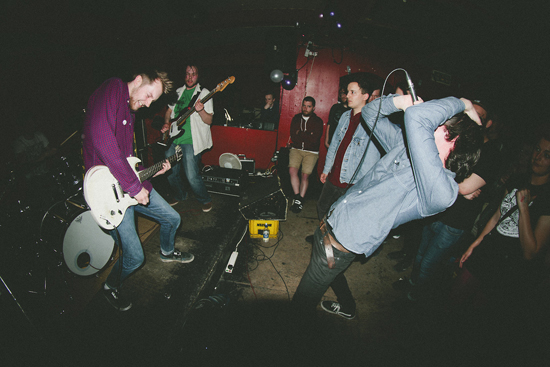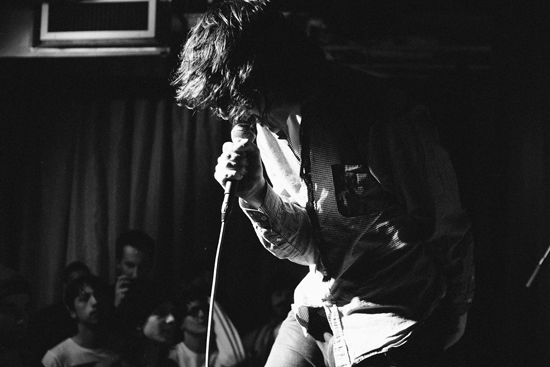Photographs courtesy of Andy North
"We want it to make you feel like you want to jump in the air or punch a wall while walking home drunk at 1 am. It needs to feel like it’s enveloping you."
Talking about his band’s self-titled debut, Plaids singer Joe Caithness offers a much better description than the one I had prepared. Converting punk records into words is never easy, appealing as they do to irrational impulses and rushes of blood. Good punk records make you want to push your earbuds so deep into your ears that you can feel the drums clattering against your skull. They make you bang your head in a crowded street and run through pain barriers. They’re more potent than any coffee bean or lurid energy drink, and more instantly gratifying than any film or novel. Trying to decode them, then, feels futile – you’ll only dilute the formula.
So, we could play spot the Plaids references and find the nods to DC’s Revolution Summer and 90s emo and post-hardcore obscurities – but it doesn’t feel particularly useful. That feeling you get – that’s still very much locked into these twelve numbered tracks (from opener ’19’, through to closer ’30’) or trapped inside the sweaty basement for the 25 minutes you watch them play. From their relatively straightforward beginnings as a hardcore punk band with a melodic core, Plaids are increasingly disinterested in writing to templates and the LP format bleeds their influences more than ever. One song, ’22’, has a galloping guitar chug straight out of Iron Maiden’s ‘The Trooper’, while there are also quiet interludes and deeper grooves than ever before.
The Nottingham four-piece are also behind one of the UK’s best DIY venues, JT Soar, where eclectic line-ups meet community vibes and carrier bags filled with Żywiec and Okocim. Imagine that at your next Converse-sponsored gig at the 100 Club, where industry types compete with competition winners to see who can talk over the bands the loudest. If that wasn’t enough to be getting on with, Caithness also runs Subsequent Mastering, through which he has mastered some of the most exciting instrumental grime tunes of recent years – a burgeoning scene with a similar disregard for traditional form.
Ahead of Plaids‘ official release date in October (pressing plant issues notwithstanding), the Quietus caught up with Caithness to talk about the album, DIY venues and parallels between punk and grime. The band has also given us the exclusive premiere of ’28’, which you can stream below;
What strikes me first about the Plaids LP is how much more room it has to breathe compared with the earlier EPs and splits. How did you approach the album differently?
Joe Caithness: We left the album for a couple of years because we wanted to get a grip of what range of stuff we wanted (and could) play – so it’s an amalgamation of all those ideas and reflections. It’s definitely the first thing we wrote as a record, as opposed to picking our favourite songs from recent sets. Some of the songs were a year old by the time they got placed there, some were written a week or so before recording.
The album has a loose concept of space which is y’know, fairly massive. What inspired that?
JC: Massive and expanding! Without sounding like a mope, I had a really shitty year in 2013, periods of near homelessness and intense depression for months, and it could have gone two ways: I could have got really drunk and high and been an asshole and tried to justify it like I was living in a movie, or to just duck out and wait for it to pass and get involved in something. I chose the second one and started to explore space and physics, and quickly found a sort of spiritualism in the quest for understanding the cosmos, which was the existential medicine I needed. The song ‘twenty three’ is about this, it’s an ode to Carl Sagan, who I spent a lot of time with, squinting at my phone while not sleeping last year. Long story short: these themes came up a lot in the lyrics, so it felt right to explore that through the aesthetics of the album sleeve and design [by Kyle McPartlin]. The front cover is an ancient star map Kyle found in an old book – that stuff is interesting because it shows humans trying to define themselves from space. It’s the beginning of what would become astronomy.
Given how you were feeling, how positive would you say the record is? I may be wrong, but from what I can tell the lyrics don’t seem to dwell entirely in the darkness?
JC: The record is actually brutally miserable in places, but expresses joy and existential wholeness in others. I just try to write what the music makes me feel and store up ideas for when Greenberg [guitarist, Matt Green] sends us a demo. His natural variety in songwriting usually means I can get a few different ideas across in one record or set, which I guess makes us come across more human.
How far do you think the Plaids sound could expand as time goes on?
JC: I’m not sure, we started off as a "hardcore punk" band with no real sub-genre or bands to rip off in mind and this just kind of came out – something melodic and structurally frantic. The LP has a few more spacey/reverb-y moments which come from listening to a load of 90s spacey indie and shoegaze stuff around the time of recording – we actually had a day for "vibes" in the recording, where we re-recorded some parts and added layers of reverb, tape delay and chorus on tracks. I’m hearing a weird mix of UK bands like Ride and Swervedriver, with the late 80s melodic hardcore stuff from DC à la One Last Wish and Rain in my head – but maybe that’s wishful thinking?
No, that sounds about right! As well as Plaids, you’re all involved in the running of the DIY venue JT Soar – how did you get started doing that?
JC: Phil [bassist Phil Booth] had access to a space, which he was using for setting up his now fully-fledged recording studio. We’d just started a little band [La Boite Diabolique] and this led us to putting on more gigs. We found the venues weren’t really giving us the vibes we were after and clocked the licencing laws were about to change in regards to live performances. The rest, as they say, is history. The best way to experience what JT is about is to simply come to a show, and there sure as hell is a lot of them.
What would you say are the main challenges that you face running a DIY space?
JC: It takes some time for some people to get it, as in, to not be a jerk. Most people come in and are a bit like "this is a bit odd" and after one can and one set they are lighting up like they are at the best house party of their life. It’s heartening. It takes a big team of people all doing their thing instinctively. It needs to be a kind of eco-system.
Why are DIY spaces important in the UK?
JC: Because playing in bars is pretty depressing, especially if they have security and they don’t let under 18s in. Also the BYOB aspect means it’s a cheap night out and people come down not knowing the bands, just to have a good time! This is great for touring bands, it means they play to enthusiastic people who may or may not have previously checked them out.

Outside of the band and venue stuff, you’re also running the grime label Special Stage Audio and have mastered tunes from Murlo, Dark0, Sd Laika and others. How did you get involved there?
JC: Yeah, SSA is a digital grime label – we push the different stuff. I’m really not interested in "white boy grime", "art grime", "post-grime" etc, we just like music that sounds terrifying and insane, music that is a bit too much in many ways. Greenberg is an artist on that label, Orbinaut, and also helps out with the A&R type stuff – which basically means we all scour SoundCloud for weirdos we can get tunes off. I also run Subsequent Mastering. As well as doing a load of new grime stuff I have done some other things folks who read the Quietus might know, such as Joanna Gruesome, Vision Fortune, The Soft Walls etc.
What would you say are the parallels between punk and grime scenes? Feel free to say there are none.
JC: Good grime and good punk have many parallels! Mostly that the good stuff in both scenes exists in a kind of angry vacuum socially. I have been more inspired recently by the DIY nature of labels like Butterz, and the fact the new grime labels are taking to Bandcamp and putting on their own events as a co-op – like Boxed – than a lot of DIY punk antics in the UK in fact!
Is there anything punk and grime can learn from each other?
JC: Grime has such a progressive nature, each artist has to be different to survive, and has to be constantly advancing musically. I wish punk could be a bit more like that. Punk is a lot more self-sufficient and organised, but I guess it’s had longer to get to that point!
Finally, what sage advice would you offer to a group of kids starting a punk band today?
JC: Don’t backwards engineer other bands’ riffs, just listen to loads of music and hit stuff.
Plaids’ self-titled debut is released in October



